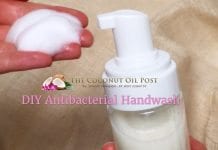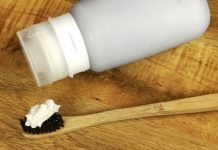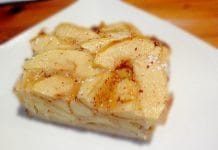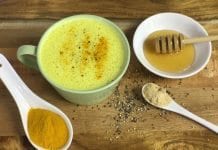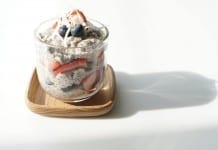I’ve written a number of articles on coconut oil pulling which generate many questions. This article goes into more detail of Coconut Oil Pulling and Why you Should Be Doing It?
Origin of Oil Pulling
Oil pulling has been called a folk remedy and likened to a homeopathic craze that has been praised by Gwyneth Paltrow and Shailene Woodley for keeping their teeth whiter and producing stronger gums. I have been oil pulling (with coconut oil) for about 3 years and have written other articles about my successes here, here and here.
Oil pulling, originating somewhere in Ancient India, is an Ayurvedic oral tradition steeped in rich cultural history some 5000 years ago. More recently (1990’s) Tummala Koteswara Rao promoted oil pulling actively after hearing about it from Russian and German sources. Tummala who is in his 60’s testifies of being cured of over four decades of allergies, sleeplessness, asthma and palpitations and his wife of over three decades of migraine headaches and other ailments.
Originally used as treatment for dryness, inflammation and burning of the mouth, oil pulling today has been discovered to help remove the buildup of plaque and bacteria sticking to teeth and bacteria trapped in crevices as well as drawing out toxins through the salivary glands through the “pulling action” where microorganisms are trapped within the oil.
Scientific Evidence of Oil Pulling
According to a study in 2008, a test between sesame oil and chlorhexidine (an antibacterial mouthwash) showed that sesame oil was successful in reducing plaque and oral bacteria. The study concluded by saying that oil pulling was an effective preventative to maintain oral health. Given the ingredients in your average mouthwash, the possibility that it can stain your teeth if used over long periods and that most of them contain sodium saccharin (artificial sweetener) I’ll take oil pulling over rinsing my mouth with that any day.
Oral Bacteria
The bacteria responsible for tooth decay are mutans streptococci which if left untreated can cause pain, inflammation, infection and tooth loss. Along with these symptoms there is also bad breath, gum disease, gingivitis and Halitosis. Some professionals have suggested that illnesses such as pneumonia, meningitis and sinusitis all stem from the bacteria Streptococcus mutans. There are also links between cardiovascular disease, diabetes, pregnancy and premature births and osteoporosis. Many oral cancer patients present a higher level of oral bacteria such as C. gingivitis and P. melaninogenica, and S. mitis.
When I visited my dentist during the time of having what was first suspected as TMJ and then after that was ruled out there was the ominous diagnosis of root canal, one of the things that my dentist showed much concern about was whether the cavity was clean of bacteria. It’s a common practice that when preparing a tooth for root canal is to pack the cavity with as much antibiotic and disinfectant as possible in order to kill off the bacteria.
Most dental patients who are immunocompromised have to be pre medicated to prevent bacteria entering the bloodstream and then lodging in another part of the body, often the heart. Whether you are immune compromised or not, it seems a reality that bacteria in the mouth can travel into the bloodstream and cause many other secondary problems. One of the concerns of root canal therapy is whether all the bacteria is actually killed off before filling the tooth and then capping it.
A Window to the Body – all disease starts in the mouth
It’s been said many times that the passageway for disease into our bodies is through our mouth. After All, it’s where we take in food and liquids to nourish our bodies but depending on the quality and quantity of food and whether it’s laden with sugar, artificial colours, flavours and additives will produce more bacteria in our mouth which will then impact our health. Centuries ago dentists practiced what was called the focal infection theory of disease. Basically the premise is that oral infection can influence the health of the entire body. The practice back then was for dentists to pull diseased teeth in the hope of preventing disease from spreading to other parts of the body. (1) Hippocrates, considered to be the father of Western medicine reports of curing a patient with arthritis by pulling an infected tooth. (2)
Dental Health and Systemic Disease
Given the amount of bacteria that flood our mouth each day (more than in a dog’s mouth), any lesion, cut, bleeding gums, ulcers or opening of the mucous membranes allow germs to enter the bloodstream. Weston A. Price, D.D.S., one of the most respected dental researchers of the early 1900’s ran numerous case studies and research on the focal infection theory. He ran many experiments on patients who had debilitating illnesses who also had teeth that had undergone root canal treatment. One patient in particular, a woman who had severe arthritis to the point of being confined to a wheelchair. Although X-rays of her root canal treated tooth showed no evidence of infection, the tooth was extracted. The tooth was then washed and surgically embedded under the skin of a rabbit. Within two days the rabbit developed the same type of crippling arthritis as the woman. After 10 days the rabbit died. The woman, now without the infected tooth, made a full recovery.(3) He ran many other experiments and treated many patients using the same technique of removing infected teeth. Many patients were almost instantly cured of kidney problems, bladder infections, ovarian diseases, spastic colitis, gall bladder and liver problems. To prove that not all teeth or foreign objects embedded into the rabbits would result in disease, he also embedded healthy sterile teeth and other objects like coins. When these objects were embedded no infections occurred and the rabbits remained healthy. Following in Dr Price’s footsteps, many other practitioners and researchers ran investigations and performed similar experiments with similar results. Dr Charles Mayo, M.D., Dr Edward C. Rosenow and Dr Martin H. Fischer to name a few.
With the introduction of penicillin and antibiotics in the 1940’s the focal infection theory seemed to lose momentum as infectious diseases were now being treated with antibiotics and new and more advanced dental techniques could repair teeth without having to extract them. However, by the early 2000’s numerous studies connecting acute and chronic illnesses with oral health begin appearing in medical and dental journals. The focal theory of infection had made a comeback. Today it is written about fairly extensively and is a widely accepted practice especially for people with heart problems or artificial joints to undergo antibiotic treatment before having any oral surgeries. In 2000, a detailed report was issued from the Surgeon General on oral health, where the connection between oral health and systemic disease was clearly outlined and documented. (4) However, while the focal theory of infection is accepted essentially by all physicians and dentists the flipside of this is that the practitioners (doctors, dentists) working in the field don’t talk or discuss the theory in any depth with patients. Partly because doctors turn to antibiotics as the best solution for secondary infections and partly because they lack the insight of the extent to which focal infections can affect overall health. If you heard that your oral health could potentially cause you a stroke or heart disease, you would probably think “yeah sure…..wait – what?”.
How Does Coconut Oil Pulling Help
Firstly, coconut oil pulling does not replace regular dental checkups. Oil pulling is rather a home oral practice that will supplement brushing and flossing. Oil pulling is an easy and relatively quick process that can be incorporated into any daily routine that will keep your mouth, teeth and gums in tip top condition. If started early enough in life, oil pulling can help you keep your original teeth for longer and requiring little to no dental work. Both my kids have been oil pulling now for at least 2 years and have had no fillings to date. While they had great teeth before they began oil pulling, they now will ensure that their oral health should be taken care of as they head into adulthood. My story is a little different due to such poor health in my childhood years and several years of antibiotics, I unfortunately have more filings in my teeth than I care to admit. However, while oil pulling can’t fix the damage done I have testified of the success that I feel is directly attributed to because of oil pulling.
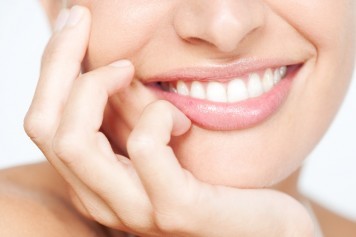 So how does coconut oil pulling work? Most bacteria or microorganisms living in the mouth are usually a single cell that are covered in a fatty membrane that will stick to fatty acids found in oils, when they come into contact. So the simple chemistry lesson is that oils like oils. The action of swishing a tablespoon of oil around in your mouth and in between your teeth creates a perfect vessel for bacteria and germs to be caught up in and eventually spat out at the end of the session into the bin. Warning: Do not swallow the oil you have pulled with! Oil pulling activates the salivary glands which then helps to draw out any deep hidden bacteria in crevices that are hard to get to even with the best of toothbrushes. The process also “pulls’ toxins and germs from within the bloodstream, helping the body to then heal itself of illness or ailments that have been in place for sometimes years. From reproductive problems, balancing hormones, headaches, allergies, asthma, fibromyalgia, insomnia, GI issues, depression and cancer. Originally called “oil gargling” by Ayurvedic practitioners, it was reintroduced as “oil pulling” by Dr. F. Karach, a physician who also practiced Ayurvedic medicine.
So how does coconut oil pulling work? Most bacteria or microorganisms living in the mouth are usually a single cell that are covered in a fatty membrane that will stick to fatty acids found in oils, when they come into contact. So the simple chemistry lesson is that oils like oils. The action of swishing a tablespoon of oil around in your mouth and in between your teeth creates a perfect vessel for bacteria and germs to be caught up in and eventually spat out at the end of the session into the bin. Warning: Do not swallow the oil you have pulled with! Oil pulling activates the salivary glands which then helps to draw out any deep hidden bacteria in crevices that are hard to get to even with the best of toothbrushes. The process also “pulls’ toxins and germs from within the bloodstream, helping the body to then heal itself of illness or ailments that have been in place for sometimes years. From reproductive problems, balancing hormones, headaches, allergies, asthma, fibromyalgia, insomnia, GI issues, depression and cancer. Originally called “oil gargling” by Ayurvedic practitioners, it was reintroduced as “oil pulling” by Dr. F. Karach, a physician who also practiced Ayurvedic medicine.
Other Oils Used for “pulling”
Because of it’s history the most common oil used was sesame oil. In the western world people have been known to pull using olive oil, sunflower oil, sesame oil and most common is coconut oil because of it’s antibacterial, and antimicrobial properties. The Lauric acid in Coconut oil, known for its antimicrobial actions is also now known for it’s ability to stop Strep mutans, the primary bacteria that cause tooth decay.
Sesame and sunflower oil have been the most widely used as they are household oils in India, but there is no right or wrong oil. You could use olive oil, avocado or even almond oil. Personally I use coconut oil because it’s a) antibacterial and antimicrobial and b) because it has a reasonably pleasant taste.
What to expect after coconut oil pulling?
First of all your teeth should feel cleaner. Depending on how well you are, will depend on the detox that may follow. As toxins become dislodged and shift the normal reaction in your body is to start dispelling whatever toxic matter has built up in your body. It might be your sinuses that begin to expel in order to unblock or in my case my uterus shed a whole heap of waste that was otherwise stuck within the muscle. You may feel a little unwell, a bit achy in the joints or get a headache. Everyone is different in the way the body releases toxins. Just be gentle with yourself and drink lots of fluids, mainly water. If you have old fillings, there is a possibility that through oil pulling they may or may not loosen. It’s not a bad thing if they do as they were either deteriorating because of further decay or poor dentistry. Either way it’s probably a good thing to have them replaced with new fillings.
How to Coconut Oil Pull:
It’s best to oil pull first thing in the morning on an empty stomach.
Rinse your mouth with some water.
Put anywhere from 1 teaspoon to 1 tablespoon of oil into your mouth.
With your mouth closed start to swish or “pull” the oil around your mouth and in between your teeth. Very similar to when you are rinsing after brushing your teeth.
“Pull” the oil for up to 20 minutes and then spit the entire contents out into the bin. Do not swallow the toxin filled oil. Do not spit it down the sink as your drain will not thank you.
Rinse your mouth with water a couple of times and spit.
I like to then brush my teeth even if it’s before breakfast but that’s optional. Some people like to rinse and then eat and then brush after eating. I brush after eating as well.
Coconut Oil Pulling Troubleshooting:
The gag factor – If you think you are going to gag because of having a whole tablespoon of oil in your mouth for 20 minutes, then work up to it. Start with a small amount of oil and less amount of time. The next time you go to pull, then add a bit more oil and a bit more time. Eventually you will get to the 20 minutes mark with a reasonable amount of oil in your mouth.
My jaws hurt – This isn’t a marathon – there’s no prise for who can “pull” oil the fastest or hardest! Relax and pull then stop for a bit and pull some more. Once you do it for a few times you will find there is a natural pattern or rhythm that you will find.
Help I can’t find time to oil pull – If you have a morning routine that includes shave, shower, blow dry hair etc etc, then you have time to oil pull. I oil pull most mornings while I’m in the shower. It takes me about 20 minutes in the bathroom and when I’m done I spit the oil out and brush my teeth as the last thing I do.
Help I’m a Mum and I have small children that constantly need me to speak to them!!
Ok this is a bit tricky and you may not always be able to oil pull first thing in the morning. Depending on how young your kidlets are and how you structure your day, you can always opt for a different time of the day to oil pull. I don’t think it’s a hard and fast rule about the timing of oil pulling. If you really want to try it – then fit it in whenever you have that time.
Here’s some suggestions –
When your kidlets are taking a morning or afternoon nap.
When your spouse is at home and can take the kidlets for awhile (I know just going to the bathroom in that space of time on your own will be like a dream come true – so take the oil with you!)
When your kids head off to school – still in the am but after the rush and hustle of getting them out the door is over.
Sometime after the kids have gone to bed – sometimes this is too late and all you want to do is collapse and go to sleep, but if you happen to be still up and your spouse doesn’t need a 20 minutes conversation then go for it – maybe the spouse can join you.
If you happen to be a homeschooler, then a quiet time scheduled sometime just after lunch might be your opportunity.
Follow this link to get more FAQ’s for oil pulling.
How about you? Do you oil pull? Which oil do you use? If you don’t would you consider trying it?
Leave me a comment or get in touch with me through facebook or twitter.
References:
(1) pg 32 Chapter 3 Oil Pulling Therapy Dr. Bruce Fife
(2) pg 33 Chapter 3 Oil Pulling Therapy Dr. Bruce Fife
(3) pgs 35/36 Ch 3 Oil Pulling Therapy Dr. Bruce Fife
(4) US Department of Health and Human Services




